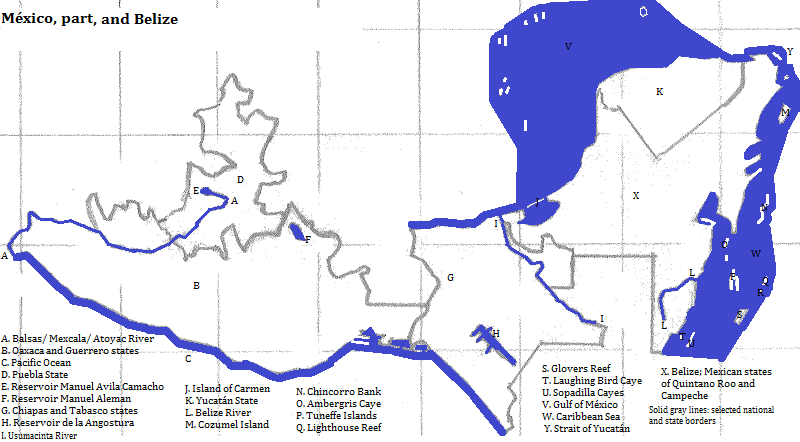A range of mountains in Guerrero and Oaxaca, the Southern Central America's northern bump is the Yucatán Peninsula, a low scrubby limestone plateau which divides the Gulf of Mexico from the Caribbean Sea.
The Southern Sierra Madre mountains continue beyond the Isthmus under various names as the spine of Central America. The high point in this area is a volano on the Chiapas/ Guatemala border: Tacaná, reaching over 4000 meters. UNESCO honors as a World Heritage Site one area: the Belize Barrier Reef Reserve System. This is one part of a large area of the Americas where Spanish and Roman Catholic Christianity represent the majority. See Southeastern Mexico Cities. Tabasco has the region's most important on-shore gas field. A sampling of pre-Columbia languages follows: I. Mayan languages spread north from Guatemala, reaching Tabasco by 800 B.C.E., and continuing to spread northward. During their cultural peak lowland Mayan languages converged, and also borrowed heavily from the unrelated Olmec language. II. Speakers of Oto-Manguean languages lived southeast of the Méxican Valley. Zapotec speakers were in Oaxaca from 1200 B.C.E. until just before the Spanish arrived when many of them spread eastward to the gulf of Tehuantepec's coast. III. The impetus for the move was the arrival of Mixteco speakers from Puebla. IV. This imperial culture may have adopted the language, perhaps previously speaking a third Oto-Manguean language, Cuicateco, when they took power. V. Before the arrival of the Zopotecs the speakers along the Gulf of Tehuantepec spoke Huave. VI. In northern Puebla Totonacan was spoken. VII. North of the Huave speakers, and also later intermixed with the Zapotecs, were the Mixe-Zoque speakers, occupying the rest of the Isthmus. VIII. The Olmecs who thrived in Tabasco and further north about 800 to 400 B.C.E. spoke a Mixe-Zoque language. The best known religions were: I. the Jaguar Cult of the Olmecs, associated with the rain god and fertility; II. A rain god, Chac, held first place among the Maya. Human sacrifice may have been a late decadent development. UNESCO honors as World Heritage Sites several pre-Columbian sites or the colonial heritage: Calakmul in Campeche; two 16th century monasteries north from Oaxaca and Puebla 1. Occidental in Spanish.Map

Who lives there?
Who was there before?
Around the Area
north from the coast
northeast from northeast Yucatan
east from the Yucatán Peninsula
southeast
southwest
northwest
Footnotes
2. Oriental in Spanish.
3. Translates as Mother Range.
4. Del Sul in Spanish.
5. Specifically: Bacalar Chico National Park on northern Ambergris Caye; the Blue Hole on Lighthouse Reef; Half Moon Caye Marine Reserve; Glovers Reef Marine Reserve; Laughing Bird Caye National Park; and Sapodilla Cayes National Park.
6. http://www.touropia.com/tourist-attractions-in-mexico/, accessed August, 2015.
7. https://en.wikipedia.org/wiki/List_of_natural_gas_fields, accessed August, 2015.
8. One in Huejotzingo, plus San Francisco de Asís in San Andrés Calpan and Asunción de Nuestra Señora in Tochimilco. All three are in Puebla State. Along with others outside they area they consistute a single World Heritage Site.